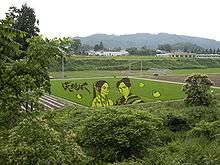Rice paddy art
Rice paddy art (田んぼアート tambo āto) is an art form originating in Japan where people plant rice of various types and colors to create a giant pictures in a paddy field.[1] [2]
History

In 1993, the people of Inakadate, Aomori were looking for a way to revitalize their village. Archaeological exploration led to a realization that rice had been grown in the area for more than 2000 years.[3] To honor this history, the villagers started a rice field behind the town hall. With the paddy as a canvas, the villagers cultivated and used four different types[3] of heirloom and modern strains of rice to create a giant picture in the field. To allow viewing of the whole picture, a mock castle tower 22 meters high was erected at the village office.[3] In 2006, more than 200,000 people visited the village to see the art.[3]
For the first nine years, the farmers created a simple picture of Mount Iwaki[4][5] before going to more complex designs.
Following Inakadate's example, other villages such as Yonezawa in Yamagata prefecture, have started to create their own tanbo art.[5]
Inakadate designs
The following is a list of the designs that have been used in the Inakadate pictures.
- 2003 – Leonardo da Vinci, "Mona Lisa"
- 2004 – Shikō Munakata – "Two Bodhisattvas and Ten Great Disciples of Shakamuni Buddha" and "Queen Mountain God"
- 2005 – Sharaku – "Otani Oniji", Utamaro – "Anthology of Poems: The Love Section"
- 2006 – Tawaraya Sōtatsu, "Fujin and Raijin"
- 2007 – Hokusai – from Thirty-six Views of Mount Fuji: "The Great Wave off Kanagawa" and "South Wind, Clear Sky"
- 2008 – Ebisu, Daikokuten
- 2009 – Sengoku military commanders, Napoleon
- 2012 - Kano Hogai - "Hibo Kannon ('Kannon the Merciful Mother') and Acala": the Seven Lucky Gods
- 2013 - Geisha and Marilyn Monroe and Ultraman
- 2015 - Gone With the Wind and Star Wars[6]
- 2016 - Shin Godzilla[7]
Production
Every April, the villagers meet and decide what to plant for the year.[3] Prior to planting, farmers sketch out the designs on computers to figure out where and how to plant the rice.[5] In 2007, 700 people helped plant rice.[3] In Inakadate, the fields used are approximately 15,000 square meters.[4] Agreements between landowners have allowed for larger pictures to be created.
Advertising controversy
In 2008, it was planned to change the lower part of the field to include the logos of Japan Airlines and To-o Nippo, a local newspaper, for a reported 2 million yen to offset increased costs. The members of the local landowners' organization, along with the former mayor, protested, saying that the land would not be leased from the following year if the plan to display advertising logos was not abandoned. The village revitalization group voted by a narrow margin not to include the advertisements, and the seedlings that were planted were removed.[8][9][10]
See also
- Tamboāto Station, a railway station built specially to serve an area famous for rice paddy art in Inakadate, Aomori
- Hill figure
- Nazca Lines
- Crop circle
References
- ↑ Fackler, Martin (2010-07-15). "Japanese Village Creates Art From Hues of Rice". The New York Times. Retrieved 10 September 2013.
- ↑ Bekku, Junichi (2012-08-19). "http://ajw.asahi.com/article/behind_news/social_affairs/AJ201208190010". The Asahi Shimbun. Retrieved 10 September 2013. External link in
|title=(help) - 1 2 3 4 5 6 Hani, Yoko (2007-08-26). "Homegrown art". The Japan Times. Retrieved 22 February 2010.
- 1 2 "Bizarre spectacle of the giant crop murals covering rice fields in Japan". Daily Mail. 2009-07-09. Retrieved 22 February 2010.
- 1 2 3 "Farmers create coloured rice 'murals' in Japan". Telegraph. 08-03. Retrieved 22 February 2010. Check date values in:
|date=(help) - ↑ http://www.inakadate-tanboart.net/
- ↑ http://www.japantoday.com/category/arts-culture/view/godzilla-appears-in-aomori-pref-as-rice-paddy-art
- ↑ 田んぼアート、広告いらない 地権者抗議で苗抜き取り – Asahi Shimbun, 4 July 2008
- ↑ 田んぼアートの広告削除へ – Too Nippo, 4 July 2008
- ↑ 田んぼアート もったいない? 企業広告絵柄を抜き取り – Mainichi Shimbun, 5 July 2008
External links
| Wikimedia Commons has media related to Rice paddy art. |
- Inakadate website (bad link?)
- Inakadate website (NEW?)
- 2012 Paddy Art Making from Inakadate website
- 2014 Paddy Art Making from Inakadate website
- Connected field paddy art in Anjō